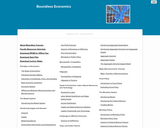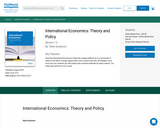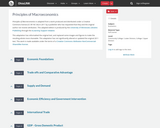
Charts related to the latest "Consumer Price Index" news release.
- Subject:
- Economics
- Social Science
- Material Type:
- Diagram/Illustration
- Provider:
- Bureau of Labor Statistics
- Date Added:
- 08/21/2023

Charts related to the latest "Consumer Price Index" news release.

This catalog contains educational content originally curated by Boundless. In collaboration with the Boundless team, Lumen Learning imported these OER courses to the Lumen Platform, to ensure they remain freely available to the education community after Boundless ceased operations. Lumen maintains the Boundless content in the same condition it was provided to us. Courses may contain issues with formatting, accessibility, and the degree to which content remains current, accurate, and complete.

Official website of the United States Bureau of Economic Analysis.

The official website of the United States Bureau of Labor Statistics.

The most common way to calculate the correlation coefficient (r) is by using technology, but using the formula can help us understand how r measures the direction and strength of the linear association between two quantitative variables.

The most common way to calculate the correlation coefficient (r) is by using technology, but using the formula can help us understand how r measures the direction and strength of the linear association between two quantitative variables.

Overview of Communism and Marxist-Leninist states. For extra coverage of the Cold War outside the scope of the AP course, click here. Created by Sal Khan.

Federal tax and spending policies can affect the economy through their impact on federal borrowing, private demand for goods and services, people’s incentives to work and save, and federal investment, as well as through other channels. CBO analyzes the economic effects of federal fiscal policies in current law as well as significant proposed changes in those policies.

The text focuses throughout on evidence on the economy, from around the world, and from history. It is motivated by questions—how can we explain what we see? The method is to ask interesting questions first and then to introduce models that help to answer them. Standard tools such as constrained optimization are taught by showing how they give insight into real-world problems. Economics as a discipline is set in a social, political, and ethical context in which institutions matter.

When workers are unemployed, they, their families, and the country as a whole lose. Workers and their families lose wages, and the country loses the goods or services that could have been produced. In addition, the purchasing power of these workers is lost, which can lead to unemployment for yet other workers.
Addressing the issue of unemployment requires information about the extent and nature of the problem. How many people are unemployed? How did they become unemployed? How long have they been unemployed? Are their numbers growing or declining? Are they men or women? Are they young or old? Are they White, or Black, or Asian, or of Hispanic ethnicity? How much education do they have? Are they concentrated in one area of the country more than another? These statistics—together with other economic data—can be used by policymakers to determine whether measures should be taken to influence the future course of the economy or to aid those affected by joblessness.

International Economics: Theory and Policy is built on Steve Suranovic’s belief that students need to learn the theory and models to understand how economics works and how economists understand the world. And, that these ideas are accessible to most students if they are explained thoroughly.
So, if you are looking for an International Economics text that will prepare your PhD students while promoting serious comprehension for the non-economics major, Steve Suranovic’s International Economics: Theory and Policy is for you.
International Economics: Theory and Policy presents numerous models in some detail; not by employing advanced mathematics, but rather by walking students through a detailed description of how a model’s assumptions influence its conclusions. Then, students learn how the models connect with the real world.
Steve’s book covers positive economics to help answer the normative questions; for example, what should a country do about trade policy, or about exchange rate policy? The results from models give students insights that help us answer these questions. Thus, this text strives to explain why each model is interesting by connecting its results to some aspect of a current policy issue.
This text eliminates some needlessly difficult material while adding and elaborating on other principles. For example, the development of the relative supply/demand structure, or the presentation of offer curves, are omitted as to not go too deeply into topics that tend to confuse many students at this level.
Steve developed new approaches in this text including a simple way to present the Jones’ magnification effects, a systematic method to teach the theory of the second best, and a unique description of valid reasons to worry about trade deficits. These new approaches help students learn the concepts and models and derive conclusions from them.
If you like to take a comprehensive look at trade policies, be sure to check out the chapter on Trade Policy (7). It provides a comprehensive look at many more trade policies than are found in many of the printed textbooks on the market today.
International Economics: Theory and Policy by Steve Suranovic is intended for use in a full semester trade course, a full semester finance course, or a one semester trade/finance course.

Gross domestic product (GDP) and gross domestic income (GDI) are in theory estimates of the same concept, namely economic production over a defined span of time and space. Yet the two measures are compiled using different source data, and the two measures often give different indications of the direction of the economy. This raises the issue of which of the two measures is a more accurate estimate of economic production. In this paper we present a time-series statistical framework for addressing this issue. Our findings indicate that the latest vintage of GDP has been a better measure of true output over the 1983-2009 period than the latest vintage of GDI. Our model also implies an optimal weighting of GDP and GDI can yield a more accurate estimate of economic output than either GDP or GDI alone. Our empirical findings indicate that a weighting of approximately 60% to GDP yields the best estimate for the 1983-2009 period. When we consider vintages of estimated output, we find that GDI often contains additional information to GDP regarding true output.

Contrasting Keynesian and Classical Thinking. Created by Sal Khan.

This is a 5 minute video that covers the labor market and what factors contribute to the laws of supply and demand to determine the amount of labor employed and wages. This video will meet standard EPF.4 with a review of EPF. 2(a) and (F) and EPF. 3(a)

Measuring Total Output and Income

Greek philosopher Heraclitis said more than 2,500 years ago that “Nothing endures but change.” Forecasting is a tricky business, but this sentiment strikes us as being as safe a bet as one can make. Change—rapid change—underlies all our lives. As we were completing this textbook, the world entered a period of marked economic uncertainty that led many students, and indeed people from all walks of life, to tune into economic events as never before to try to understand the economic world around them. So, while we as economists have the public’s attention, we see an opportunity to share economics principles and the economic way of thinking in a way that emphasizes their relevance to today’s world. We use applications from sports, politics, campus life, current events, and other familiar settings to illustrate the links between theoretical principles and common experiences. Because of the increasingly global nature of economic activity, we also recognize the need for a clear and consistent international focus throughout an economics text. In addition, we have tried to provide a sense of the intellectual excitement of the field and an appreciation for the gains it has made, as well as an awareness of the challenges that lie ahead.

ussell Cooper and Andrew John have written an economics text aimed directly at students from its very inception. You're thinking, ”Yeah, sure. I've heard that before.“
This textbook, Macroeconomics: Theory Through Applications, centers around student needs and expectations through two premises: … Students are motivated to study economics if they see that it relates to their own lives. … Students learn best from an inductive approach, in which they are first confronted with a problem, and then led through the process of solving that problem.
Many books claim to present economics in a way that is digestible for students; Russell and Andrew have truly created one from scratch. This textbook will assist you in increasing students' economic literacy both by developing their aptitude for economic thinking and by presenting key insights about economics that every educated individual should know.

This paper introduces new users to the basics of the U.S. national income and product accounts (NIPAs). It discusses the economic concepts that underlie the NIPAs, and it describes the seven NIPA summary accounts. The Primer also provides a brief overview of the derivation of the NIPA measures and a list of references for further information.

William Phillips observed a correlation between unemployment and inflation. Generally, high inflation is associated with low unemployment, and vice versa. This relationship makes sense, as high employment gives workers more leverage, increasing wages and demand for goods and services. However, there are exceptions, such as stagflation in the 1970s and low inflation with low unemployment in the late 1990s. Created by Sal Khan.

This is a Principles of Macroeconomics Course developed through the Ohio Department of Higher Education OER Innovation Grant. This work was completed and the course was posted in January 2019. The course is part of the Ohio Transfer Assurance Guides (TAGs) as OSS 005. For more information about credit transfer between Ohio colleges and universities, please visit: www.ohiohighered.org/transfer.Team LeadAmyaz Moledina College of WoosterContent ContributorsRosemarie Emanuele Ursuline CollegeKenneth Fah Ohio Dominican UniversityDarcy Hartman Ohio State University – NewarkLibrarianNathan Wolfe Kenyon CollegeReview TeamSeth Kim Central Ohio Technical CollegeJoe Nowakowski Muskingum University